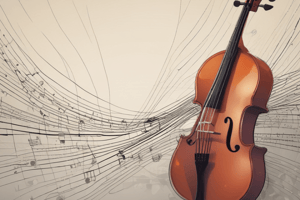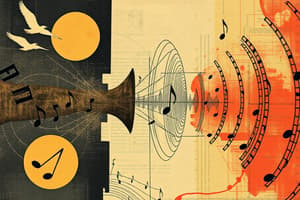Podcast
Questions and Answers
What does the abbreviation Hz represent in musical terms?
What does the abbreviation Hz represent in musical terms?
- Harmonic wave frequency
- Cycles per second (correct)
- Duration of pitch
- Intensity of sound
Which of the following is NOT considered a fundamental characteristic of musical tone?
Which of the following is NOT considered a fundamental characteristic of musical tone?
- Pitch
- Duration
- Timbre
- Harmony (correct)
Why is understanding basic musical elements important before studying music structure?
Why is understanding basic musical elements important before studying music structure?
- To avoid unnecessary complications
- To enhance the fluency in music theory (correct)
- To memorize music history
- To create original compositions
Which of the following aspects of music will be emphasized in this study?
Which of the following aspects of music will be emphasized in this study?
What is the intended goal of the book's study of music?
What is the intended goal of the book's study of music?
What occurs when a vibrating surface causes an increase in air pressure?
What occurs when a vibrating surface causes an increase in air pressure?
How is pitch determined in a sound?
How is pitch determined in a sound?
Which property of sound is measured in decibels?
Which property of sound is measured in decibels?
What describes the periodic motion that creates sound?
What describes the periodic motion that creates sound?
What is the range of audible sounds for the human ear?
What is the range of audible sounds for the human ear?
What is typically felt as the loudness or softness of a pitch?
What is typically felt as the loudness or softness of a pitch?
What is the term for the gradual increase and decrease of air pressure in sound waves?
What is the term for the gradual increase and decrease of air pressure in sound waves?
Which of the following describes a sound of definite pitch?
Which of the following describes a sound of definite pitch?
What defines the position of middle C on the staff?
What defines the position of middle C on the staff?
What does the symbol 'b' represent in music notation?
What does the symbol 'b' represent in music notation?
In Western music, what is the smallest interval used?
In Western music, what is the smallest interval used?
How does a double sharp symbol affect a note?
How does a double sharp symbol affect a note?
What does the dot placed to the right of a note head do?
What does the dot placed to the right of a note head do?
What is the effect of a tie in music notation?
What is the effect of a tie in music notation?
Which of the following statements about enharmonic equivalents is true?
Which of the following statements about enharmonic equivalents is true?
What is represented by the written designation C4?
What is represented by the written designation C4?
What does the term 'fortissimo' signify in music notation?
What does the term 'fortissimo' signify in music notation?
Which of the following terms represents a gradual increase in volume?
Which of the following terms represents a gradual increase in volume?
What does 'fp' stand for in musical notation?
What does 'fp' stand for in musical notation?
What does the upper number in a simple meter signature represent?
What does the upper number in a simple meter signature represent?
Which of the following can be used to describe rhythm?
Which of the following can be used to describe rhythm?
During which century did mensural notation begin to develop?
During which century did mensural notation begin to develop?
What was the primary purpose of neumatic notation?
What was the primary purpose of neumatic notation?
What characterizes compound meter?
What characterizes compound meter?
Which term applies to meter signatures that cannot be divided into equal groups of 2, 3, or 4 beats?
Which term applies to meter signatures that cannot be divided into equal groups of 2, 3, or 4 beats?
What is the meaning of the term 'mezzo forte'?
What is the meaning of the term 'mezzo forte'?
Which of the following notation systems is noted for including both pitch and durational values?
Which of the following notation systems is noted for including both pitch and durational values?
What is syncopation in terms of rhythm?
What is syncopation in terms of rhythm?
What does 'dim.' signify in music notation?
What does 'dim.' signify in music notation?
Which of the following descriptions fits dynamic markings?
Which of the following descriptions fits dynamic markings?
In a meter signature where the upper number is 6, what type of meter is this likely to represent?
In a meter signature where the upper number is 6, what type of meter is this likely to represent?
What does 'irregular divisions and subdivisions' refer to in music?
What does 'irregular divisions and subdivisions' refer to in music?
What is the correct direction for stems when a note is placed on the middle line of the staff?
What is the correct direction for stems when a note is placed on the middle line of the staff?
When connecting eighth notes with beams, what is important to consider?
When connecting eighth notes with beams, what is important to consider?
How should the stems be oriented for two melodies occupying the same staff?
How should the stems be oriented for two melodies occupying the same staff?
What is the appropriate use of flags in music notation?
What is the appropriate use of flags in music notation?
In a compound meter, what should be clearly shown?
In a compound meter, what should be clearly shown?
What notation is used for an irregular division of a beat or measure?
What notation is used for an irregular division of a beat or measure?
When notating vocal music, what has been the traditional use of flagged notes?
When notating vocal music, what has been the traditional use of flagged notes?
What is the preferred method for representing a full measure of rest?
What is the preferred method for representing a full measure of rest?
Flashcards
Sound
Sound
The sensation that our ears perceive when sound waves reach them.
Vibration
Vibration
The periodic motion of a substance, causing pressure changes in the air.
Compression
Compression
The increase in air pressure caused by sound waves.
Rarefaction
Rarefaction
Signup and view all the flashcards
Frequency
Frequency
Signup and view all the flashcards
Pitch
Pitch
Signup and view all the flashcards
Intensity
Intensity
Signup and view all the flashcards
Acoustics
Acoustics
Signup and view all the flashcards
Fundamental elements of Music
Fundamental elements of Music
Signup and view all the flashcards
Duration
Duration
Signup and view all the flashcards
Timbre
Timbre
Signup and view all the flashcards
Ledger line
Ledger line
Signup and view all the flashcards
C clef
C clef
Signup and view all the flashcards
Octave identification
Octave identification
Signup and view all the flashcards
Accidentals
Accidentals
Signup and view all the flashcards
Interval
Interval
Signup and view all the flashcards
Enharmonic equivalents
Enharmonic equivalents
Signup and view all the flashcards
Half-step motion
Half-step motion
Signup and view all the flashcards
Tie
Tie
Signup and view all the flashcards
Irregular Division
Irregular Division
Signup and view all the flashcards
Rhythm
Rhythm
Signup and view all the flashcards
Meter
Meter
Signup and view all the flashcards
Simple Meter
Simple Meter
Signup and view all the flashcards
Compound Meter
Compound Meter
Signup and view all the flashcards
Duple, Triple, Quadruple Meters
Duple, Triple, Quadruple Meters
Signup and view all the flashcards
Asymmetrical Meters
Asymmetrical Meters
Signup and view all the flashcards
Syncopation
Syncopation
Signup and view all the flashcards
pp (pianississimo)
pp (pianississimo)
Signup and view all the flashcards
p (piano)
p (piano)
Signup and view all the flashcards
mp (mezzo piano)
mp (mezzo piano)
Signup and view all the flashcards
mf (mezzo forte)
mf (mezzo forte)
Signup and view all the flashcards
f (forte)
f (forte)
Signup and view all the flashcards
ff (fortissimo)
ff (fortissimo)
Signup and view all the flashcards
cresc. (crescendo)
cresc. (crescendo)
Signup and view all the flashcards
decresc. (decrescendo) or dim. (diminuendo)
decresc. (decrescendo) or dim. (diminuendo)
Signup and view all the flashcards
Stem
Stem
Signup and view all the flashcards
Beam
Beam
Signup and view all the flashcards
Stem direction
Stem direction
Signup and view all the flashcards
Beam thickness
Beam thickness
Signup and view all the flashcards
Ledger line stems
Ledger line stems
Signup and view all the flashcards
Beaming rhythms
Beaming rhythms
Signup and view all the flashcards
Beaming in compound meter
Beaming in compound meter
Signup and view all the flashcards
Stem direction in multiple melodies
Stem direction in multiple melodies
Signup and view all the flashcards
Study Notes
Introduction
- Music is fundamentally about sound and time
- Understanding sound is crucial for playing/singing
- Sounds are structured in time by duration
- Sounds and the spaces between them are both important in music
Sound
- Sound is how vibrations are perceived by the hearing organs as they reach the ears.
- Vibration is measured and repeated movement of a substance
- Vibrations from an instrument's parts and surrounding air create sound waves
- Compression and rarefaction are the alternation between pressure increases and decreases in the air.
The Four Properties of Sound
- Pitch: The highness or lowness of a sound, determined by frequency.
- Higher frequency equals higher pitch
- Tone: A definite musical sound with a particular pitch.
- Intensity (Amplitude): Loudness or softness of a sound, measured in decibels.
- Measured from 0 to 130 decibels
- Duration: The length of time a note or pitch is sounded.
- Meter: Regular pulses of equal duration in a timed pattern
- Rhythm: A succession of notes of uneven durations, working together with the beat
Harmonic Series
- Harmonic series: A series of pitches created simultaneously by a vibrating body (e.g., string) .
- Partials (or harmonics): Individual pitches within the harmonic series.
- Fundamental: The first partial, the lowest frequency.
- Frequency: Number of compression/rarefaction cycles per second (usually measured in hertz).
- Audible frequency range is 20–20,000 Hz
Timbre
- Timbre is sound quality/color.
- How we distinguish between sounds, e.g., clarinet and oboe
- Characterized by the vibrating body's shape, material and how it's in motion (e.g., striking, bowing, blowing)
Musical Notation
- Music notation: More precise and complex than language
- Pitch: Represents highness/lowness by symbols on a staff
- Staff: A set of horizontal lines
Clefs
- Clefs: Symbols placed at the beginning of a staff to indicate the letter names of lines and spaces
- Treble clef: Ornate G, designates the letter G on the second line.
- Bass clef: Dots above/below the fourth line, designates F.
- Grand staff: Two interconnected staves
Accidentals
- Sharp (#): Raises pitch by a half step.
- Flat (b): Lowers pitch by a half step.
- Natural (𝄢): Cancels an accidental.
- Double sharp: Raises pitch by two half steps.
- Double flat: Lowers pitch by two half steps.
Intervals
- Interval: Relationship between two tones.
- Half step: Smallest interval using two adjacent keys
Duration
- Beats: Regular pulses
- Durational values: Note/rest values such as whole, half, quarter notes, etc.
- Meter: regular pattern of strong/weak beats
- Meter signatures: (time signatures) show the beat pulse pattern (numerator/denominator)
- Irregular divisions/subdivisions: Note values divided into any number of equal parts
Rhythms
- Rhythm: Motion of music in time
- Pulse: Beat: the rhythmic unit
Syncopation
- a part of a measure with unexpected/unstressed accents
Dynamic Markings
- Dynamic markings indicate the general volume of music.
History of Notation
- Neumatic notation: Used from 650–1200.
- Mensural notation: Developed in the 13th century with additional time/duration values
- Modern notation: Gradual evolution from previous methods.
Studying That Suits You
Use AI to generate personalized quizzes and flashcards to suit your learning preferences.




